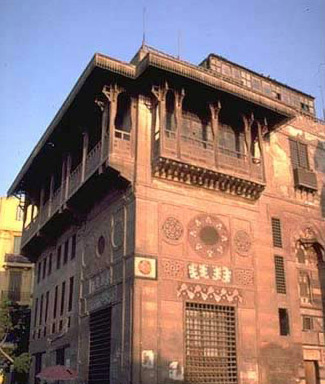The Sabil-Kuttab of Sultan Qaytbay (Qaitbay)
by Jimmy Dunn writing as Ismail Abaza

The freestanding and elegant sabil-kuttab of Sultan Qaytbay is situated on Sabila street between the complex of Shaykhu and the right-hand side of the square below the Citadel, and, while perhaps not the most major of all Islamic monuments in Cairo, is well worth a visit for travelers who may find themselves in Islamic Cairo a anyway.
Qaytbay ruled Egypt for some 29 years and was known as a patron of art and prolific builder. Of his many other structures, the best known is his mausoleum at the "City of the Dead" (which is depicted on the one pound Egyptian note) and his military edifices that crown the harbor in Alexandria.
This is the first example of a freestanding version of this type of institution, which prior to this, had usually been incorporated into a corner of a mosque or madrasa (Islamic school). During the Ottoman period, this type of independent structure became a favorite type of urban charitably endowed building, for it provided economically and efficiently two mercies most commended by the Islamic faith, that of water to the thirsty and instruction to the ignorant. The sabil-kuttab of Sultan Qaytbay offers a good example of the trend in the later Mamluk period to apply a variety of rich decoration to the exterior of buildings.

While built by Sultan Qaytbay in 1479, the upper structure, a kuttab, or elementary school, is a fairly recent restoration. It has a trilobed portal on its western facade, and large iron-grilled windows. Below, the facades of the sabil, a public fountain, are all very richly decorated with polychrome marble inlay and carved stone in a style that approximates that used in the later mosque of Qijmas al-Ishaqi.

After the ablaq courses of red, white and black were renewed on the groin-vaulted trilobed (three rounded projections) portal, its inlaid pattern and carved detail became more visible and was thus restored to its original glamour. To either side of the portal vault are carved medallions with the name and epithet of Sultan al-Ashraf Abu 'l-Nasr Qaytbay. Today, this entrance is no longer in use, as the interior is now accessed through a plain door in the back of the building.
The lintels are not only joggled in the tradition of the Bahri Mamluk period, but are inlaid with blue and white marble that forms a variety of intricate arabesque patterns on the facade. Above each window is two such decorative slabs one over the other, and both are surmounted by medallions inlaid with arabesques in the same style and framed by carved moldings. There are also bits of red stone and ceramic that enhance the effect of stone and marble interaction. It is certainly worthwhile to take a few minutes here to carefully examine the roundels, lintels, joggles and corner columns of the facades since the marble veneer and carving are exceptionally fine.
Today, this building is in use and is not generally open to the public, but its main attraction at any rate is its exterior.


References:
|
Title |
Author |
Date |
Publisher |
Reference Number |
|
Historical Cairo (A Walk Through the Islamic City) |
Antonious, Jim |
1988 |
American University in Cairo Press, The |
ISBN 977-424-497-4 |
|
Islamic Monuments in Cairo, A Practical Guide |
Paker, Richard B.; Sabin, Robin; Williams, Caroline |
1985 |
American University in Cairo Press, The |
ISBN 977 424 036 7 |
|
Islamic Architecture in Cairo: An Introduction |
Behrens-Abouseif, Doris |
1992 |
E. J. Brill |
ISBN 90-04-08677-3 |

